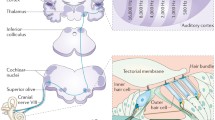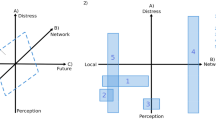Keypoints
-
1.
Different methods have successfully been used for detecting tinnitus-related changes in the brain; chief among them are neuroimaging, electroencephalography and magnetoencephalography.
-
2.
These methods make it possible to detect noninvasively neuronal activity in the human brain and determine the anatomical location of the activity.
-
3.
Findings from neuroimaging have already contributed to a better understanding of the pathophysiological changes underlying the different forms of tinnitus
-
4.
The different neuroimaging methods hold the potential to be further developed as methods for diagnosis, outcome assessment, and outcome prediction.
-
5.
Replication of studies with larger sample sizes and clinically well-characterized individuals with tinnitus is needed.
Access provided by Autonomous University of Puebla. Download chapter PDF
Similar content being viewed by others
Keywords
- Tinnitus
- Neuroimaging
- Electroencephalography
- Magnetoencephalography
- Functional magnetic resonance tomography
- Positron emission tomography
- Diagnosis
- Pathophysiology
Introduction
Many forms of tinnitus are phantom perceptions of sound and therefore related to functional changes in the brain. Identification of the “neuronal correlate” of such forms of tinnitus is of utmost importance for a deeper understanding of the pathophysiology and the development of new effective treatments for these kinds of tinnitus. It should be stressed that tinnitus is most likely a network property and that the “neural correlate” should be understood as such, and should not be viewed as one phrenological “tinnitus hotspot” somewhere in the brain. Several different methods have been increasingly used during the last two decades for the detection of tinnitus-related changes in the brain and in attempts to find where in the brain the physiologically abnormal neural activity is generated and to which extent the pathophysiological changes in humans correspond to those in animal models of tinnitus. In detail, these methods are structural and functional neuroimaging methods and source-localized electroencephalography (EEG) and magnetoencephalography (MEG). These methods make it possible to detect neuronal activity noninvasively in the human brain and determine the anatomical location of the activity. Even the most cautious interpretation of the available data, most of them come from small samples, indicates the potential of neuroimaging, EEG, and MEG as valuable tools in tinnitus research. These methods provide windows to the brain that allow detecting the localization of tinnitus-related changes in the brain. This knowledge is indispensable for a better understanding of the pathophysiology of tinnitus (see Chap. 21). Very importantly, imaging techniques can be applied both in animals and in humans and can so contribute to bridge the gap between the knowledge coming from clinical data and animal models of tinnitus [1].
Neuroimaging may not only serve as a tool for improved understanding of the pathophysiology but also have an impact on future diagnosis and treatment of tinnitus patients. This can be best illustrated by the recent development of brain stimulation techniques for the treatment of tinnitus (see Chaps. 88 and 90). Neuroimaging findings of increased neural activity in the auditory cortex of tinnitus patients prompted the suggestion to treat tinnitus by focal modulation of this activity with electric or magnetic stimulation. Neuroimaging has the potential to be further developed as an objective diagnostic tool for tinnitus. Most findings from studies of tinnitus-related brain changes come from comparison of groups of individuals with tinnitus with matched groups of individuals who do not have tinnitus. The results of such studies do not automatically mean that each individual with tinnitus has an identical abnormality as the ones detected when groups of individuals are compared. Further studies with larger sample sizes will be needed to estimate sensitivity and specify of different techniques for the diagnosis of tinnitus, since there is not yet enough evidence that any of the presented methods can be recommended for use in routine diagnostic management of tinnitus patients.
A further potential application of neuroimaging is for distinguishing between different forms of tinnitus. It may be assumed that differences in the perceptual characteristics of tinnitus, in the emotions surrounding tinnitus and in the response to specific treatments, would be reflected by specific patterns of neural activity, which could be detected by the use of imaging techniques. By contributing to this differential diagnosis, imaging may in the future also serve as predictor of the efficacy of specific treatments and for the assessment of treatment outcome. This will help to exactly identify the neuronal mechanisms by which specific treatment interventions exert their effects. This knowledge in turn can be useful for improving efficacy of those treatment interventions.
Whereas EEG and MEG measure directly the electrical and magnetic field, which is induced by neuronal activity, “functional imaging” methods such as functional Magnetic Resonance Imaging (fMRI) or Positron Emission Tomography (PET) measure changes in cerebral blood flow, blood oxygenation, and glucose uptake based on the assumption that alterations of neuronal activity are reflected by changes in the hemodynamic or metabolic responses. Results of the use of these methods in the investigation of tinnitus and the results from such studies are summarized in the following chapters.
Tinnitus-related functional changes of neural activity have been investigated with fMRI, PET, and Single Positron Emission Computed Tomography (SPECT). The different methods differ in the correlates of neuronal activity they detect (e.g., cerebral blood flow or glucose uptake) and in their ability to measure resting neuronal activity or stimulus-evoked changes of neuronal activity. Results from the use of these methods for the study of tinnitus will be presented in detail in Chap. 18. High-resolution Magnetic Resonance Imaging (MRI) data have demonstrated changes in the volume of specific brain structures in tinnitus patients. However, it remains to be elucidated, whether these alterations are a consequence of longer lasting changes in functional activity or whether they rather represent a marker for increased vulnerability to develop tinnitus. This will be discussed further in Chap. 19.
Chapter 20 concerns electrophysiologic methods for studies of neural activity. While the EEG records the electrical field, which is produced by neural activity, MEG records the magnetic field changes. The use of MEG and EEG is based on the assumption that electrical activity either from electrodes placed on the scalp (EEG) or from measurement of the small changes in the magnetic field that can be measured outside head (MEG) correlates with neural activity in populations of nerve cells. Typically, EEG is recorded by many electrodes placed over the surface of the scalp. Signals recorded by these electrodes can be used to construct a map of the brain’s electrical activity. Both EEG and MEG are characterized by high temporal but low spatial resolution. MEG is more sensitive for currents that are directed tangential to the surface of the skull, whereas EEG detects radial sources best. Both methods have the advantage that they do not produce noise that can interfere with auditory recordings as the imaging methods do. EEG and MEG can be used both for measuring resting brain activity and for recording neural activity elicited by sound.
Abbreviations
- EEG:
-
Electroencephalography
- fMRI:
-
Functional magnetic resonance imaging
- MEG:
-
Magnetoencephalography
- MRI:
-
Magnetic resonance imaging
- PET:
-
Positron emission tomography
- SPECT:
-
Single positron emission computed tomography
Reference
Paul, A K, Lobarinas, E, Simmons, R, Wack, D, Luisi, J C, Spernyak, J, Mazurchuk, R, bdel-Nabi, H, and Salvi, R (2008) Metabolic imaging of rat brain during pharmacologically-induced tinnitus. Neuroimage 15;44(2):312–8
Author information
Authors and Affiliations
Corresponding author
Editor information
Editors and Affiliations
Rights and permissions
Copyright information
© 2011 Springer Science+Business Media, LLC
About this chapter
Cite this chapter
Langguth, B., De Ridder, D. (2011). Objective Signs of Tinnitus in Humans. In: Møller, A.R., Langguth, B., De Ridder, D., Kleinjung, T. (eds) Textbook of Tinnitus. Springer, New York, NY. https://doi.org/10.1007/978-1-60761-145-5_17
Download citation
DOI: https://doi.org/10.1007/978-1-60761-145-5_17
Publisher Name: Springer, New York, NY
Print ISBN: 978-1-60761-144-8
Online ISBN: 978-1-60761-145-5
eBook Packages: MedicineMedicine (R0)




